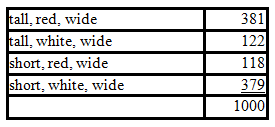Broad-spectrum antibiotics inhibit the growth of most intestinal bacteria. Consequently, assuming that nothing is done to counter the reduction of intestinal bacteria, a hospital patient who is receiving broad-spectrum antibiotics is most likely to become _____.
A) unable to fix carbon dioxide
B) antibiotic resistant
C) unable to synthesize peptidoglycan
D) deficient in certain vitamins and nutrients
D
You might also like to view...
The surfaces of clay particles in soil ____
a. often bear positively charged ions b. release water to plants easily c. often bear negatively charged ions d. are generally hydrophobic e. acidify the soil
This cross is not useful to determine if one of the genes is linked to the others. Which gene?
In peas, tall (T) is dominant to short (t), red flowers (R) is dominant to white flowers (r), and wide leaves (W) is dominant to narrow leaves (w). A tall plant that has red flowers and wide leaves is crossed to a short plant that has white flowers and narrow leaves. The resulting progeny are shown in the table.

A) gene T
B) gene R
C) gene W
D) This cross shows that all three genes are linked.
In 2004, archaeologists unearthed a female skeleton on the Indonesian island of Flores that led to its classification as a member of the genus Homo instead of Australopithecus because of
A) a bone structure that reflected a raised brow of the skeleton. B) a bone structure that suggested she was able to walk upright and her type of chewing ability. C) the presence of a furrowing suture in the occipital lobe. D) the absence of complex tools for hunting. E) the absence of frontal molars in the jaw.
Bacterial ________ are sites of metabolite storage
A) nucleoids B) vacuoles C) inclusions D) pili E) periplasm